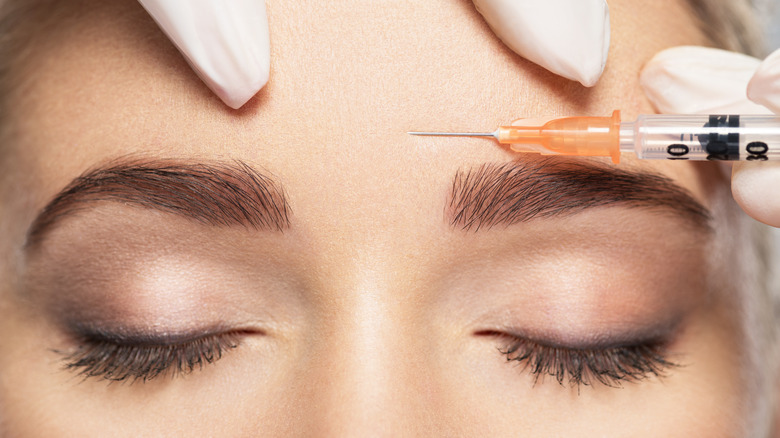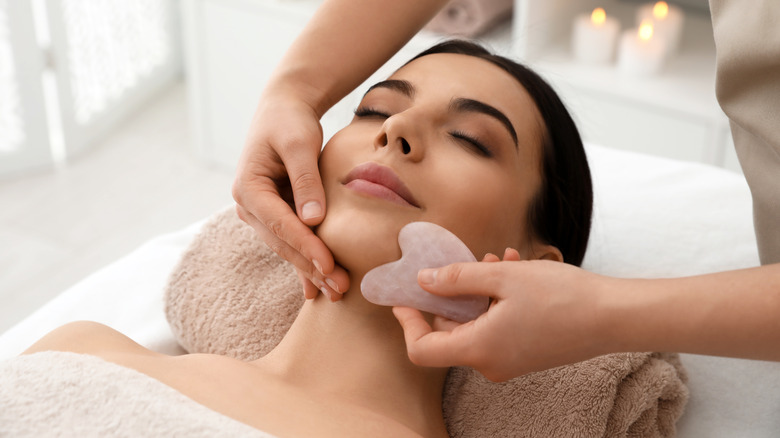Botox Tolerance Is Rare But Real. Here's What We Know About This Risk
Over the past few decades, the use of Botox, along with other anti-aging neuromodulators, has become more widespread than ever. From its introduction in 2000 to 2019, the total number of Botox procedures performed rose by 878%, per a report by the American Society of Plastic Surgeons. These days, patients as young as their early 20s are turning to the rejuvenating injectable in hopes of preventing fine lines and wrinkles before they start. Although some critics balk at the idea of preventative Botox treatments, many skincare experts support the growing practice. "This is a generation who is getting facials and taking care of their skin and using natural makeup. Doing Botox to prevent aging and to prevent wrinkle formation has just become an extension of that," plastic surgeon Ashley Amalfi tells The Washington Post.
It's obvious that skincare enthusiasts love using Botox. However, a troubling phenomenon has emerged that's got fans of the neuromodulator feeling rather uptight. It's called Botox tolerance or resistance, and while some are reluctant to acknowledge its existence, others are sounding the alarm. But should you be concerned? Let's take a further look at what you need to know regarding Botox immunity.
What experts are saying about Botox tolerance
Unfortunately for Botox lovers, tolerance to Botox is very real. According to a study published in the Archives of Plastic Surgery, some patients can develop an immunological response to the neuromodulator, resulting in decreased effects or tolerance to its paralyzing properties. Of course, Botox works by "freezing" facial movement and softening lines, so this can pose a huge dilemma for those who are affected. You may have a tolerance to Botox if your injections yield lackluster effects, wear off much more quickly than anticipated, or worse, appear to do nothing at all.
Fortunately, however, the risk of developing Botox tolerance is quite rare, according to professionals. While a small amount of the population may produce antibodies to the ingredients in Botox, few patients will exhibit signs of true Botox tolerance or resistance to treatment. One study published in the medical journal Clinical, Cosmetic, and Investigational Dermatology suggested that higher doses or more frequent visits could be linked to Botox tolerance. "It's an extremely rare phenomenon. I've been injecting for over 30 years and have seen very few true cases. Most often, the patients who feel they are non-responders require treatment of a different dose or distribution," Dr. Brian Biesman tells Aedit. Furthermore, some providers note that true Botox tolerance can be easily mistaken for other issues.
How to prevent and counteract Botox tolerance
Curious as to how you can stop the signs of Botox tolerance in their tracks? Some providers say it's as simple as switching products. Botox is one of several neuromodulators available for cosmetic use, and each type performs slightly differently, which means that you may not react to, say, Dysport the same way as Botox. "[Botox tolerance] can be overcome using higher doses, more frequent injections, or switching to another brand," Dr. Joshua Zeichner tells Allure. Other injectable options to choose from include Xeomin, Jeuveau, and Myobloc. One thing to keep in mind is that those with severe allergies to cow milk should steer clear of Dysport, as it's derived from cow's milk protein.
If you're one of the few individuals who experience complete resistance to Botox, don't fret. There are countless options, available both over the counter and in-office, that can help prevent and reduce the signs of aging skin. Treatments like microneedling, laser treatments, acupuncture, and topicals are just a few of the dermatological interventions available for those who need a break from Botox. Take comfort in the fact that advancements in skincare technology are unfolding each day; in fact, today, there are even LED masks and microcurrent devices you can add to your skincare routine at home.


